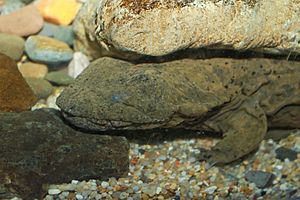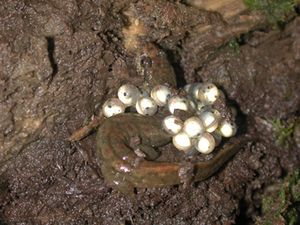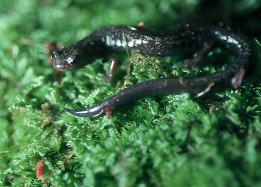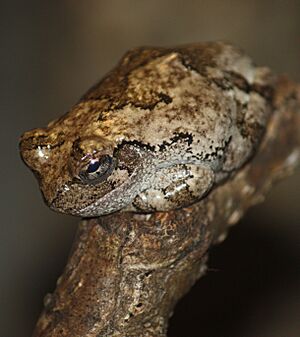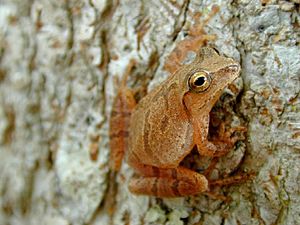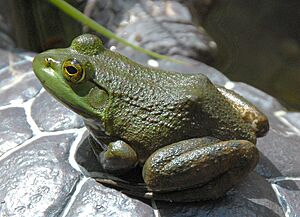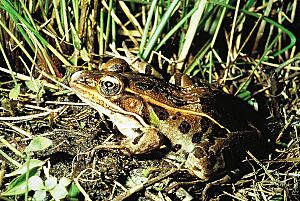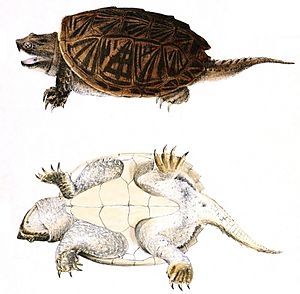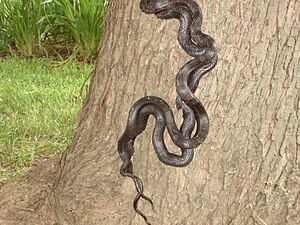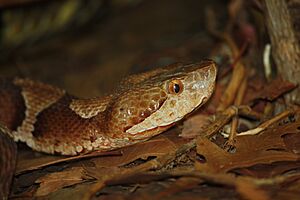List of amphibians and reptiles of West Virginia facts for kids
West Virginia is home to many amazing creatures, including 89 different kinds of amphibians and reptiles! These cool animals are split into two main groups: amphibians (like frogs and salamanders) and reptiles (like snakes, lizards, and turtles).
You can find about 34 types of salamanders, 15 kinds of frogs and toads, 21 different snakes, 13 turtle species, and 6 lizard species living across West Virginia. Some of these animals are very special because they are found nowhere else in the world! For example, the Cheat Mountain salamander and the West Virginia spring salamander live only in West Virginia. The Cheat Mountain salamander is considered a threatened animal, and the West Virginia spring salamander is even more rare, listed as endangered. This means they need our help to survive and thrive!
Contents
Meet the Amphibians and Reptiles!
Here's a list of the amphibians and reptiles you might find in West Virginia. Some are easy to spot, while others are very shy!
| C | Common | You can often see these animals in their usual homes. |
| U | Uncommon | These are harder to spot because they might hide a lot or live in special places. |
| R | Rare | You won't often find these, even in places where they should live. |
Salamanders (Order Urodela)
Salamanders are amphibians that look a bit like lizards, but they have smooth, moist skin and usually live near water.
Giant Salamanders (Family Cryptobranchidae)
- Eastern hellbender (Cryptobranchus a. alleganiensis) C
Waterdogs and Mudpuppies (Family Proteidae)
- Common mudpuppy (Necturus m. maculosus) C
Mole Salamanders (Family Ambystomatidae)
- Jefferson salamander (Ambystoma jeffersonianum) U
- Spotted salamander (Ambystoma maculatum) C
- Marbled salamander (Ambystoma opacum) C
- Small-mouth salamander (Ambystoma texanum) R
- Streamside salamander (Ambystoma barbouri) R
True Salamanders (Family Salamandridae)
- Red-spotted newt (Notophthalmus v. viridescens) C
Lungless Salamanders (Family Plethodontidae)
These salamanders don't have lungs; they breathe through their skin!
- Northern dusky salamander (Desmognathus fuscus) C
- Allegheny Mountain dusky salamander (Desmognathus ochrophaeus) C
- Seal salamander (Desmognathus monticola) C
- Black mountain salamander (Desmognathus welteri) U
- Blackbelly salamander (Desmognathus quadramaculatus) U
- Red-backed salamander (Plethodon cinereus) C
- Ravine salamander (Plethodon richmondi) C
- Northern ravine salamander (Plethodon electromorphus) C
- Valley and ridge salamander (Plethodon hoffmani) C
- Shenandoah Mountain salamander (Plethodon virginia) U
- Cumberland Plateau salamander (Plethodon kentucki) C
- Cheat Mountain salamander (Plethodon nettingi) R
- Northern slimy salamander (Plethodon glutinosus) C
- White-spotted slimy salamander (Plethodon cylindraceus) C
- Wehrle's salamander (Plethodon wehrlei) C
- Cow Knob salamander (Plethodon punctatus) U
- Four-toed salamander (Hemidactylium scutatum) C
- Northern spring salamander (Gyrinophilus p. porphyriticus) C
- Kentucky spring salamander (Gyrinophilus porphyriticus duryi) C
- West Virginia spring salamander (Gyrinophilus subterraneus) R
- Midland mud salamander (Pseudotriton montanus diastictus) U
- Northern red salamander (Pseudotriton r. ruber) C
- Green salamander (Aneides aeneus) U
- Southern two-lined salamander (Eurycea cirrigera) C
- Northern two-lined salamander (Eurycea bislineata) C
- Long-tailed salamander (Eurycea l. longicauda) C
- Spotted-tail salamander (Eurycea lucifuga) U
Frogs and Toads (Order Anura)
Frogs and toads are amphibians known for their jumping abilities and calls.
American Spadefoot Toads (Family Scaphiopodidae)
- Eastern spadefoot (Scaphiopus holbrookii) R
True Toads (Family Bufonidae)
- Eastern American toad (Anaxyrus a. americanus) C
- Fowler's toad (Anaxyrus fowleri) C
Tree Frogs and Allies (Family Hylidae)
- Eastern cricket frog (Acris c. crepitans) U
- Blanchard's cricket frog (Acris blanchardi) R
- Gray treefrog (Dryophytes versicolor) C
- Cope's gray treefrog (Dryophytes chrysoscelis) C
- Appalachian mountain chorus frog (Pseudacris brachyphona) C
- Upland chorus frog (Pseudacris feriarum) U
- Northern spring peeper (Pseudacris c. crucifer) C
True Frogs (Family Ranidae)
- American bullfrog (Lithobates catesbeianus) C
- Northern green frog (Lithobates clamitans melanota) C
- Wood frog (Lithobates sylvaticus) C
- Northern leopard frog (Lithobates pipiens) U
- Pickerel frog (Lithobates palustris) C
Turtles (Order Testudines)
Turtles are reptiles with a hard shell that protects their body.
Snapping Turtles (Family Chelydridae)
- Common snapping turtle (Chelydra s. serpentina) C
Pond Turtles (Family Emydidae)
- Spotted turtle (Clemmys guttata) R
- Wood turtle (Glyptemys insculpta) U
- Eastern box turtle (Terrapene c. carolina) C
- Northern map turtle (Graptemys geographica) U
- Ouachita map turtle (Graptemys o. ouachitensis) R
- Eastern painted turtle (Chrysemys p. picta) C
- Midland painted turtle (Chrysemys picta marginata) C
- Red-eared slider (Trachemys scripta elegans) C
- Eastern river cooter (Pseudemys c. concinna) U
- Northern red-bellied cooter (Pseudemys rubriventris) U
Mud Turtles and Musk Turtles (Family Kinosternidae)
- Common musk turtle (Sternotherus odoratus) C
Softshells (Family Trionychidae)
- Northern spiny softshell turtle (Apalone s. spinifera) C
- Smooth softshell turtle (Apalone m. mutica) R
Scaled Reptiles (Order Squamata)
This group includes lizards and snakes, which are known for their scales.
Spiny Lizards (Family Phrynosomatidae)
- Eastern fence lizard (Sceloporus undulatus) C
Whiptails (Family Teiidae)
- Eastern six-lined racerunner (Aspidoscelis s. sexlineata) U
Skinks (Family Scincidae)
- Little brown skink (Scincella lateralis) U
- Five-lined skink (Plestiodon fasciatus) C
- Broad-headed skink (Plestiodon laticeps) U
- Northern coal skink (Plestiodon a. anthracinus) U
Colubrid Snakes (Family Colubridae)
Most snakes in West Virginia belong to this family.
- Queen snake (Regina septemvittata) C
- Northern watersnake (Nerodia s. sipedon) C
- DeKay's brown snake (Storeria d. dekayi) U
- Northern redbelly snake (Storeria o. occipitomaculata) C
- Eastern ribbon snake (Thamnophis s. saurita) U
- Eastern garter snake (Thamnophis s. sirtalis) C
- Smooth earth snake (Virginia valeriae) U
- Eastern hognose snake (Heterodon platirhinos) U
- Eastern worm snake (Carphophis a. amoenus) C
- Northern ringneck snake (Diadophis punctatus edwardsii) C
- Northern black racer (Coluber c. constrictor) C
- Northern rough green snake (Opheodrys a. aestivus) U
- Smooth green snake (Opheodrys vernalis) C
- Corn snake (Pantherophis guttatus) R
- Eastern ratsnake (Pantherophis alleghaniensis) C
- Northern pine snake (Pituophis m. melanoleucus) R
- Eastern kingsnake (Lampropeltis g. getula) R
- Black kingsnake (Lampropeltis nigra) C
- Eastern milk snake (Lampropeltis t. triangulum) C
Vipers (Family Viperidae)
These snakes are venomous, so it's best to observe them from a safe distance!
- Northern copperhead (Agkistrodon contortrix mokasen) C
- Timber rattlesnake (Crotalus horridus) C
Images for kids
See also
- Fauna of West Virginia
- West Virginia State Wildlife Center, a place to see native West Virginia animals


